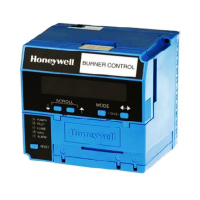65-0106—2 16
• Flame signal measurement—all installations.
• Hot refractory saturation test—all installations using
Infrared (lead sulfide) Flame Detectors.
• Hot refractory hold-in test—all installations.
• Ignition interference test—all installations using
flame rods.
• Ignition spark pick-up—all installations using Ultra-
violet Flame Detectors.
• Response to other ultraviolet sources—all installa-
tions using Ultraviolet Flame Detectors.
• Flame signal with hot combustion chamber—all
installations.
• Safety shutdown tests—all installations.
See Fig. 14 for location of component parts and see
Fig. 7 or Q7800 Specifications for terminal locations.
PRELIMINARY INSPECTION
Perform the following inspections along with proce-
dures specified by the equipment manufacturer to avoid
common problems. Make certain that:
1. Wiring connections are correct and all the terminal
screws are tight.
2. Flame detector(s) is clean, installed and positioned
properly. Consult the applicable Instructions.
3. Correct combination of amplifier and flame detec-
tor(s) is used. See Table 2 in the Specifications.
4. Plug-in amplifier is securely in place.
5. Burner is completely installed and ready to fire; con-
sult equipment manufacturer instructions. Fuel lines are
purged of air.
6. Combustion chamber and flues are clear of fuel and
fuel vapor.
7. Power is connected to the system disconnect switch
(master switch).
8. Lockout switch is reset (push in reset pushbutton)
only if the RM7823A is powered, see Figs. 1 and 2.
9. System is in the STANDBY condition. POWER LED
is energized.
10. All limits and interlocks are reset.
RM7823A
CHECKOUT
TABLE 5—FLAME SIGNAL.
Minimum
Acceptable Maximum
Flame Flame Signal Steady Dc Expected
Detector Amplifier Voltage
a
Dc Voltage
Flame Rod R7847A,B
c
1.25 Vdc 5.0 Vdc at the
Photocell Keyboard Display
C7012A,C Module
C7012E,F R7847C
b
C7015A R7848A,B
c
or
C7027A R7849A,B
c
C7035A 5.0 Vdc at a
C7044A volt-ohmmeter
C7076A,D R7886A
a
This minimum or a stronger signal should be easily obtained if the detector is correctly installed and positioned to properly
sense the flame. This voltage must be obtained before completing checkout.
b
The flame signal amplifier circuitry is tested one-half second every five seconds during burner operation and shuts down the
burner if the amplifier fails (all installations).
c
The flame amplifiers are AMPLI-CHECK™ type.
Fig. 14—Flame signal measurement.
FLAME SIGNAL MEASUREMENT
Measure the flame signal at the appropriate times defined
in the following checkout tests. Read the flame signal volts dc
at the flame amplifier test jacks + and—(Com).
1. Use a 20 kohm/voltmeter with a 0 to 10 Vdc capability.
2. Set the 20 kohm/voltmeter to the 0 to 10 Vdc range.
3. Insert the positive (red) probe into the + jack of the
flame amplifier. Insert the negative (black) probe into the—
(Com) jack of the flame amplifier.
4. Allow a few seconds for the meter reading to stabilize.
5. If using AMPLI-CHECK™ or shutter check amplifi-
ers, read the average stable voltage, disregarding the peaks
caused by the self-checking operation.
6. The meter reading must be as specified in Table 5 after
all tests are completed and all adjustments are made.
NEGATIVE (-)
METER LEAD
POSITIVE (+)
METER LEAD
20K OHM/
VOLT METER
M7554

